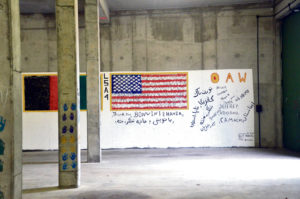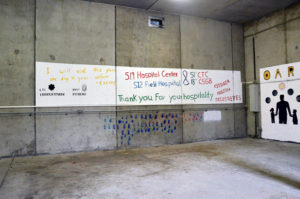
Ushered out of Afghanistan and finding themselves in the middle of the Kaiserslautern Military Community, the last of the Afghan travelers left U.S. Army Garrison Rheinland-Pfalz Oct. 9.
More than 34,900 Afghan evacuees traveled through Ramstein Air Base and Rhine Ordnance Barracks since Aug. 20. ROB accommodated approximately 12,000 travelers and hosted over 2,000 support personnel with operations managed by the 21st Theater Sustainment Command.
“Supporting this mission required coordination of garrison support at various levels,” said Henry Kaaihue, garrison directorate of plans, training, and mobilization. “There is a lot of coordination within the garrison to make old, shuttered and uninhabited buildings operational and inspecting and ensuring they have utilities and are livable.”
Overall, 29 large fest type tents were erected on the garrison’s footprint to house the travelers in eight zones called ‘Life Support Areas’ while more than 800 Soldiers augmenting the operation lived in 14 barracks throughout Baumholder, Miesau, and Sembach.
“We did not have the living space on ROB to just house all the travelers and supporting Soldiers overnight,” said Greg Williams, directorate of public works chief. “We had to use all of the capabilities we had, like opening barracks that were shuttered, finding ways to heat and power the tents, and ensure barracks were operationally ready for occupants.”
According to Williams, maintaining all the facilities, infrastructure and support operations was not an easy task, but the garrison was able to adapt to mission support requirements quickly.
“This was a very large mission for our team and we were able to accomplish it without degradation of services to the community,” said Williams. “What the team accomplished throughout the mission is outstanding, and they made it seem easy, which is even more incredible.”
Hygiene and fuel
The temporary living quarters meant the garrison needed hygiene points for the travelers, done via contracts. A total of 272 showers and latrines and 213 handwashing stations were placed throughout the LSAs.

As the mission’s timeline extended, the temperatures began to drop. The low temps created a need for heated tents and the Army needed fuel to generate the heat.
“Approximately 100,000 liters of fuel flowed through ROB during the entirety of the mission,” said George Brown, garrison DPW administration and operations branch chief.
“The garrison is extremely helpful for missions like OAW because they have the ability to quickly create and expand upon existing contracts relatively easy,” said Capt. Alexander Lovely, 21st TSC. “This allows for us to get the needed resources quickly.”
Contracting a partnership to fuel effectiveness
The quick contracting ability that Lovely is referring to comes via the garrison’s logistics partnership with the 405th Army Field Support Brigade. The garrison worked collectively with the brigade to provide full-spectrum support.
Contracts that were created or expanded include:
Cleaning the DPC area after mission completion
Custodial cleaning
Emergency quarters for service members
Heating equipment and lighting for LSAs four
Pest control
Play sand for the children in the DPC
Privacy fence screening
Coordinating with multiple units can create confusion, but the garrison had rotating designated operations liaison officers like Billy Whisler. His role was to be the communicator, coordinator, and tracker for tasks like escort operations and work orders.
“My job was to make sure we were on the same page as other organizations,” said Whisler, “We wanted to ensure integration of the appropriate and necessary garrison services and operations to meet mission needs. When you are dealing with multiple units operating in different capacities, information, coordination and synchronization is key. Being present with other key personnel lessens the risk for miscommunication.”
The DES difference
Funding and communication are key to the success of the mission but so was the safety of the travelers, service members and community members.
The garrison’s directorate of emergency services increased the force protection of the camp site and assisted with bus escorts from ROB to Ramstein Air Base along with medical transports to Landstuhl Regional Medical Center.
“We conducted approximately 195 bus escorts to and from Ramstein Air Base for approximately 12,000 travelers,” said Terry Dunlap, deputy director of garrison directorate of emergency services. “We did one to five round trips daily with anywhere from one to five buses at a time.”
FMWR team weaves in ‘community’
Providing soldiers access to gyms and morale items like coffee fell to the garrison’s directorate of family and morale, welfare and recreation. DFMWR extended 548 additional hours at the gyms on Miesau and Sembach, and increased ROB’s Java Café hours.
Their mission didn’t just stop with the Soldiers. The DFMWR team threw in 160 soccer balls for the travelers, four rolls of artificial turf and soccer goals creating a mini-soccer field within the compound of the DPC. DFMWR also provided numerous activities kits, consisting of board games, sports equipment and gear. As a result various board game tournaments, other games and competitive sporting activities were created within the various LSAs boosting morale and easing the stress of their transition.
A whole team approach
Further contributions from the directorates of human resources, resource management, religious support office, and other garrison directorates and staff offices provided a stable, efficient foundation for its client, the 21st TSC and Ramstein Air Base, to operate. The garrison’s entire effort from the time the first aircraft touched down until the final flight left the runway at Ramstein was nothing short of amazing, according to Michael Amarosa, deputy to the garrison commander.
“From top to bottom, this team showed why IMCOM professionals are simply the best, putting people first and showing what the gold standard for a ‘Ready Garrison’ looks like. The garrison team was able to come together in a short amount of time and do remarkable things in support of the mission,” he said. “Thank you to all of the garrison team members and partners who came together to make this mission a success.”


